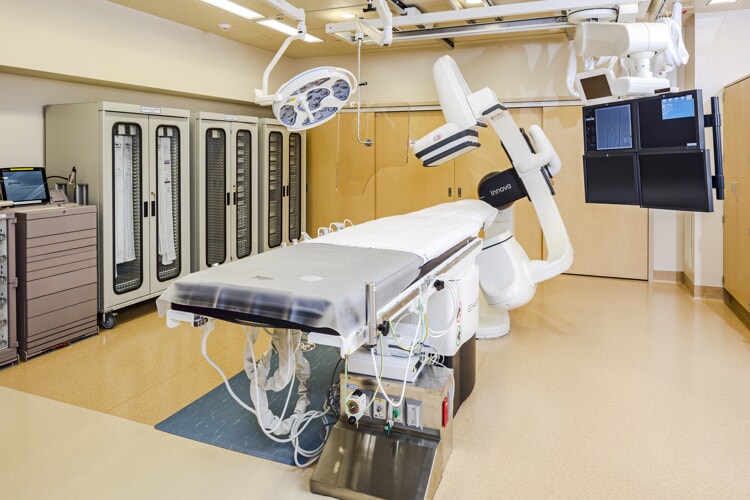
Cardiac Catheterization Lab
Healing Hearts Close to Home
 To make cardiac care accessible to the southern region of Tulare County,
with the support of the Sierra View Local Health Care District Board of
Directors and the Sierra View Foundation, Sierra View Medical Center opened
Porterville’s only Cardiac Catheterization (Cath) Lab in 2017. Sierra
View’s clinical staff and support teams provide the Cardiac Cath
Lab with diagnostic, preventative, and interventional services close to
home. 90% of procedures are same-day, with many cardiac patients going
home only hours after receiving life-saving care.
To make cardiac care accessible to the southern region of Tulare County,
with the support of the Sierra View Local Health Care District Board of
Directors and the Sierra View Foundation, Sierra View Medical Center opened
Porterville’s only Cardiac Catheterization (Cath) Lab in 2017. Sierra
View’s clinical staff and support teams provide the Cardiac Cath
Lab with diagnostic, preventative, and interventional services close to
home. 90% of procedures are same-day, with many cardiac patients going
home only hours after receiving life-saving care.
Since its opening, the Cardiac Cath Lab has continued its heartfelt community efforts by providing new cardiac services with state-of-the-art equipment. Receiving its Percutaneous Coronary Intervention (PCI) certification in 2020, the Cardiac Cath Lab offers PCI care to evaluate, diagnose, and treat patients experiencing chest pain and heart attacks. The quality cardiac care provided has not gone unnoticed, as the Cardiac Cath Lab was listed in the 2022 U.S. News & World Report's “Best Hospitals” guidebook for submitting quality data to the ACC’s National Cardiovascular Data Registry (NCDR).
Patients receiving heart care and undergoing cardiac procedures at SVMC’s Cardiac Cath Lab can do so with confidence that the quality of care they are receiving close to home aligns with national standards for safe, high-quality care.
Services Offered
- Cardioversion: Cardioversion uses quick low-energy shocks to restore a heart rhythm that is too fast or irregular. Having a Cardioversion should improve symptoms associated with a fast or irregular heartbeat such as fatigue, heart palpitations, shortness of breath, and dizziness or fainting.
- Carotid angiography: Carotid angiographies are used to find blockages in the carotid arteries in the neck that carry blood to the brain. A thin, flexible tube (catheter) is inserted into a blood vessel in the groin or arm and threaded through the carotid arteries. A special dye allows the carotid arteries to be visible on video where a cardiologist can diagnose narrowing or a blockage.
- Implanted defibrillators: Implanted defibrillators are small electronic devices placed in the chest to detect and stop irregular heartbeats. They continuously monitor the heart and produce an electric shock when needed to restore normal heart rhythms. Different from pacemakers, implanted defibrillators are used for life-threatening rapid heart rhythms that occur in the lower chamber of the heart.
- Left and right heart catheterization: Heart catheterization is used to show how well the heart is pumping. A thin, flexible tube is inserted into a blood vessel in the neck, groin, or arm. Once inserted, it is threaded through the left or right side of the heart to measure blood pressure and oxygen in both the heart and lungs.
- Percutaneous Coronary Intervention (PCI) stent procedures: PCI stent procedures are used to open blocked coronary arteries, blood vessels that deliver blood to the heart. The procedure uses a small balloon to reopen the blocked artery and increase blood flow. PCI stent procedures can improve symptoms such as chest pain and shortness of breath.
- Permanent pacemakers: Permanent pacemakers are small electronic devices placed in the chest to regulate slow electrical problems with the heart. Pacemakers stabilize abnormal heart rhythms by signaling the heart when to beat. Having a pacemaker should improve symptoms associated with an irregular heartbeat such as fatigue, lightheadedness, and fainting.
- Transesophageal echocardiogram (TEE): TEE uses an echo test that produces sound waves to create a picture of the heart. The pictures are created from the inside of the body by inserting a thin, flexible tube (endoscope) down the esophagus. TEE can diagnose multiple cardiac issues such as blood clots, infections, and tumors.
Related Physicians
-
Ashok Behl MD - Cardiology View Profile
-
Ankur Gupta MD - Cardiology View Profile
-
Bindusagar H Reddy MD - Cardiology View Profile
-
Anil Reddy Anumandla MD - SVMC Medical Office Building
263 Pearson Drive
View Profile
Porterville, CA 93257
559-793-4123 -
Nallathamby Thayapran MD - Cardiology View Profile